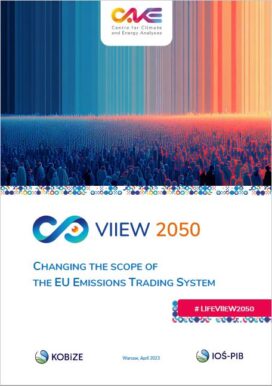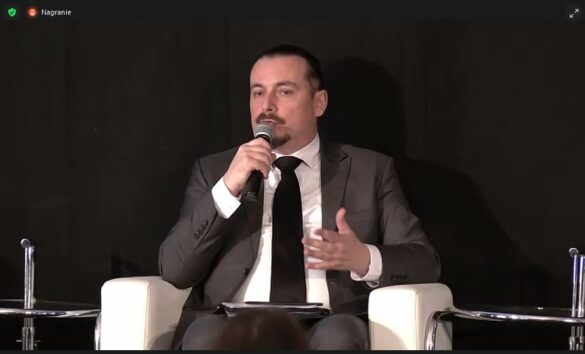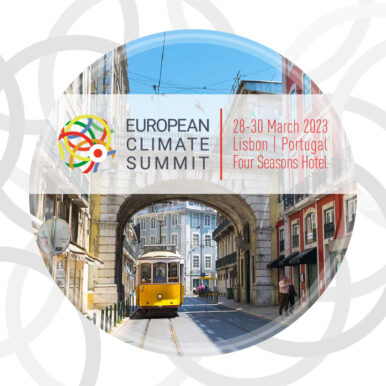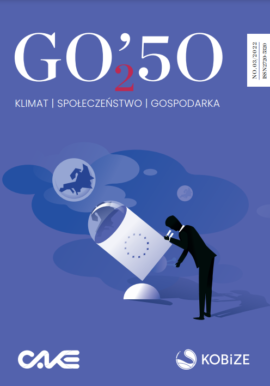
With great pleasure we are presenting the newest CAKE/KOBiZE analysis: „VIIEW on EU ETS 2050: Changing the scope of the EU ETS” made as part of the LIFE VIIEW 2050 project. The publication is available in English.

 VIIEW on EU ETS 2050: Changing the scope of the EU ETS (7.5 MiB, 1,597 hits)
VIIEW on EU ETS 2050: Changing the scope of the EU ETS (7.5 MiB, 1,597 hits)
The published report presents possible configurations of the policy up to 2050, which encompasses emission allowances trading, including various options of extending it to cover new sectors and their impact on the economy, which will be a key part of the debate and decision making process towards the end of this decade.
In the Centre for Climate and Energy Analyses we have developed and are constantly improving a suite of computational tools, thanks to which we are able to scrutinise and assess current and future climate and energy policy proposals at both the EU and country level. In the current analysis, we present and analyse six scenarios which cover possible solutions regarding the extension of the EU ETS. We consider including just the road transport sector (RT) or both the buildings road transport sectors (BRT) in the current EU ETS, creating separate systems (EU ETS and BRT ETS), and creating a single system for all sectors of the economy. The results show the consequences that each of these solutions will bring for the economy of the European Union and Poland.
Our simulations show that including new sectors in the ETS system will lead to an increase in the marginal reduction costs, mainly due to more expensive mitigation options available in the sectors which are currently not covered by emissions trading. In the scenario where the EU ETS and BRT ETS function as separate systems (which is consistent with the policy proposals up to 2030), the marginal reduction costs in the EU ETS increase from approx. 180 EUR/t CO2 equivalent in 2030 to 440 EUR/ t CO2 equivalent in 2050. While these costs might seem high from today’s perspective, for other scenarios they are even higher. For example, including the transport sector in the EU ETS could drive the cost up to 640 EUR/ t CO2 equivalent in 2050, while including both the buildings and road transport sectors could push the cost up to 800 EUR/ t CO2 equivalent in 2050. From the mid-century perspective, we observe the highest increase in the cost for the scenario in which we include all the sectors of the economy in the emissions trading system.
From a macroeconomic perspective, covering the buildings and road transport by emissions pricing has a negligible impact on household consumption in the EU, however we can observe some differences across regions. In the long term, Southern Europe will be the main beneficiary of the extension of the ETS, while Poland could see a slight loss in the 2030s, and a slight gain in the following decade. Furthermore, covering these sectors by emissions pricing leads to an increase in efficiency at the level of the EU. As the analysis shows, extending the EU ETS system to cover buildings and road transport in the countries where there is a deficit in allowances (as is the case in Poland) is a better solution than operating separate systems.
The results of the analysis confirm the key role of the electricity generation sector in achieving the zero-emission target in 2050, mainly due to its high potential in reducing emissions. At the same time, with the constant decarbonisation of this sector, extending the EU ETS has little impact and despite differences in emission prices the energy mix does not differ significantly under the various scenarios. This shows that even under a low emission price scenario, the power sector fully utilises its reduction potential.
Emissions from the road transport sector account for around a quarter of EU emissions, therefore transforming this sector is crucial to achieving climate neutrality. Covering this sector by an emissions trading system will lead to an increase in the price of operating fossil fuel vehicles. In the case of passenger cars the average increase between 2030 and 2050 could reach 30% for the EU. This will increase the cost competitiveness of zero emission vehicles (electric and hydrogen) and their share could reach 40% in 2030 and 70% in 2050. The increase in the cost of heavy-duty road freight transport could be even two-fold, and toward 2050 we could expect a large share of hydrogen (share of 60%) and electric (share of 20%) powered vehicles. Covering the agriculture sector with an emission trading system could possibly lead to a serious drop in production, negatively impacting farmers’ incomes, and virtually eliminating food exports, as well as importing half of the food consumed in the EU.
The report also points to the special role of technological and natural options of carbon capture, which will be necessary to achieve climate neutrality.
The analysis was performed using advanced modelling tools developed by CAKE experts. Such an extensive and comprehensive analysis was possible thanks to the implementation of the LIFE VIIEW 2050 project – The impact assessment of the EU Emission Trading System with the long-term vision for a climate neutral economy by 2050 implemented at KOBiZE with the financial support of the LIFE Program and the National Fund for Environmental Protection and Water Management.

European Climate Summit 2023 event organized by the International Emissions Trading Association (IETA) were held on the 28-30 March 2023 in Lisbon. Robert Jeszke, CEO of the CAKE also took part in the meeting in the 1st Plenary Session – „The EU ETS by 2030 and Beyond”.

The discussion focused on the “FitFor55” package, carbon border taxation, established new funds to drive the lowcarbon transition and the future of EU’s new climate targets for 2040 to be proposed next year. The main questions addressed to speakers concerned:
Among the distinguished speakers were:
 Robert Jeszke said the stricter LRF and MSR will lead to lack of new EUA’s in 2040 (no auctions). The EUETS we see now will come to the end in 2040. The question is if we still want ETS as a main driver for emission reduction in 2030 or focus on taxation/saparate ETS’s. CAKE has been finishing a huge LIFEVIIEW2050 analysis on extending the scope of EUETS and its impact on EU economy to 2050. One of the results is ETS2 abatement costs would be much more higher than in EUETS after 2030 and push pressure on EUA’s after merging both systems.
Robert Jeszke said the stricter LRF and MSR will lead to lack of new EUA’s in 2040 (no auctions). The EUETS we see now will come to the end in 2040. The question is if we still want ETS as a main driver for emission reduction in 2030 or focus on taxation/saparate ETS’s. CAKE has been finishing a huge LIFEVIIEW2050 analysis on extending the scope of EUETS and its impact on EU economy to 2050. One of the results is ETS2 abatement costs would be much more higher than in EUETS after 2030 and push pressure on EUA’s after merging both systems.
Link to video: European Climate Summit (ECS 2023) – DAY 1 (ieta.org)

CAKE will be present at the European Climate Summit 2023 (ECS2023) organized by the International Emissions Trading Association (IETA) taking place 28-30 March 2023 in Lisbon.
During the conference, Robert Jeszke, the CEO of the Centre for Climate and Energy Analysis (CAKE) is going to participate in the 1st Plenary – The EU ETS by 2030 and Beyond, which will take place on the 29th March.
The discussion in this panel would focus on the Fit For 55 package, carbon border taxation, established new funds to drive the low- carbon transition and the future of EU’s new climate targets for 2040 to be proposed next year. The main questions to be addressed concern: How will the EU ETS evolve by 2030 and beyond? Is further ETS sector expansion inevitable? What are the key challenges with the EUETS cap reaching zero by 2040?
The discussion will be moderated by Ewa Krukowska, from Bloomberg and among the distinguished speakers in the 1 st Panel on the EU ETS are:
Beatriz Yordi, Director, DG Climate Action – European Commission
Peter Liese, Member of the European Parliament, Rapporteur on EU ETS Review
Stefano De Clara, Head of Secretariat – International Carbon Action Partnership (ICAP)
Nuno LACASTA, Executive Board President – Portuguese Environment Agency
Kavita Ahluwalia, Vice President and Head of Global Positioning – Uniper & Co-Chair, IETA EU Working Group.
Looking forward to see you in Lisbon!


We invite you to read our third publication of the periodic “GO2’50. Climate. Society. Economy.” (No3/2022) prepared by the National Center for Emission Management and the Center for Climate and Energy Analysis. Publication is available in the Polish and English language.
 GO2'50. Climate.Society.Economy._vol.3/2022 (5.1 MiB, 231 hits)
GO2'50. Climate.Society.Economy._vol.3/2022 (5.1 MiB, 231 hits)
 „GO2’50. Klimat. Społeczeństwo. Gospodarka.” (Nr 03/2022) (5.1 MiB, 272 hits)
„GO2’50. Klimat. Społeczeństwo. Gospodarka.” (Nr 03/2022) (5.1 MiB, 272 hits)

The preparation and creation of the next issue of the publication meets the need to provide adequate knowledge on issues related to the broadly understood climate and energy policy and related to the need to carry out the transformation to a low-carbon economy by 2050. We are pleased to present to you some interesting topics that are and will be in the near future widely discussed.
The year 2022 was certainly the time which we will all remember because of the very difficult geopolitical situation in the world caused by Russia’s aggression against Ukraine. The need to change the directions of fossil fuel supplies, mostly less carbon-intensive gas, as a result of Russia’s attack on Ukraine, intensified the process of the revaluation of, and changed the approach to, climate and energy policy. In these new circumstances, there were significant changes in the list of European priorities in favour of supply security and as quick cessation of fuel imports from Russia as possible. This does not mean, however, that climate policy and greenhouse gas emission reductions, particularly those of emissions from the combustion of fuels, in the EU lost prominence.
Mindful of the importance of the circumstances outlined above, we have the pleasure to present to you studies by our Authors who address issues which are and will be in the nearest time the subject matter of heated discussions as part of progress in the implementation of the Fit for 55 package. One of the key prerequisites for success is a reform of the present EU ETS system, including the expansion of its scope to cover new sectors or the introduction of new regulatory instruments, such as the carbon border adjustment mechanism (CBAM). Given the scope of necessary measures, there is a need to tackle the costs which the EU Member States will have to incur as part of the energy transition on the pathway to achieve the climate neutrality goals. In this context, the EU support measures will be indispensable, including, among others, Just Transition, to mitigate the impacts of the transition, the new European Bauhaus, to support cities and citzens, or the introdction of equivalent measures to reduce emissions. Actions will also need to be taken at the international level, specifically, to operationalise and implement the market mechanisms under Article 6 of the Paris Agreement.
We warmly invite you to read the new issue of the publication!
Please be informed that the correspondence address of the National Centre for Emissions Management has changed.
The new address is:
ul. Słowicza 32,
02-170 Warsaw
Poland